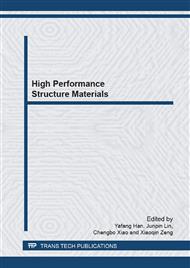[1]
Y.F. Liang, F. Ye, J.P. Lin, Y. Wang, L.Q. Zhang, G. Chen, Effect of heat treatment on mechanical properties of heavily cold-rolled Fe-6. 5wt%Si alloy sheet, Sci. China Tech. 53 (2012) 1008-1011.
DOI: 10.1007/s11431-010-0125-1
Google Scholar
[2]
Y.F. Liang, F. Ye, J.P. Lin, Y.L. Wang, G.L. Chen, Effect of annealing temperature on magnetic properties of cold rolled high silicon steel thin sheet, J. Alloy. Compd. 49 (2010) 268-270.
DOI: 10.1016/j.jallcom.2009.10.118
Google Scholar
[3]
T. Ros Yanez, Y. Houbaert, V.G. Rodriguez, High-silicon steel produced by hot dipping and diffusion annealing. J Appl Phys. 91 (2002) 785-789.
DOI: 10.1063/1.1449445
Google Scholar
[4]
P. Guigon, O. Simon, Roll press design-influence of force feed systems on compaction. Powder Technology. 35 (2003) 341-365.
DOI: 10.1016/s0032-5910(02)00223-1
Google Scholar
[5]
H. Haiji, K. Okada, T. Hiratani, M. Abe, M. Ninomiya, Magnetic properties and workability of 6. 5% Si steel sheet. J Magn Magn Mater. 160 (1996) 109-114.
DOI: 10.1016/0304-8853(96)00128-x
Google Scholar
[6]
Y. Takada, M. Abe, S. Masuda, J. Inagaki, Commercial scale production of Fe-6. 5wt. % Si sheet and its magnetic properties. J Appl Phys. 64 (1988) 53-67.
DOI: 10.1063/1.342373
Google Scholar
[7]
W.M. John., E. Nagy, Modeling of materials synthesis in hybrid plasma reactors: production of silicon by thermal decomposition of SiCI4. Metallurgical Transactions B. (1989)589-598.
DOI: 10.1007/bf02667872
Google Scholar
[8]
Y.F. Liang, J.P. Lin, F. Ye, Y.J. Li, Y.L. Wang, G.L. Chen, Microstructure and mechanical properties of rapidly quenched Fe-6. 5 wt. % Si alloy, J. Alloy. Compd. 504 (2010) 476.
DOI: 10.1016/j.jallcom.2010.03.075
Google Scholar
[9]
D. Bouchara, M. Fagot, J. Degauque, J. Bras, Ordering influence on magnetic properties of rapidly quenched Fe-6. 5 wt% Si. J Magn Magn Mater. 83 (1990) 377-382.
DOI: 10.1016/0304-8853(90)90554-4
Google Scholar
[10]
Z.Y. Cai, L.X. Zhang, Y.G. Li, Preparation of Fe-6. 5%Si sheet by electrochemical reduction. Hydrometallurgy of China. 2 (2005) 41-45.
Google Scholar
[11]
Y.J. Wei, L. Anand, Grain-boundary sliding and separation in polycrystalline metals: application to nanocrystalline fcc metals. Journal of the Mechanics and Physics of Solids. 52 (2004) 2587-2616.
DOI: 10.1016/j.jmps.2004.04.006
Google Scholar
[12]
Y. Han, J. Shi, L. Xu, W.Q. Cao, H. Dong, Effects of Ti addition and reheating quenching on grain refinement and mechanical properties in low carbon medium manganese martensiteic steel. Materials and Design. 34(2012) 427-434.
DOI: 10.1016/j.matdes.2011.08.015
Google Scholar
[13]
T. Watanabe, H. Fujii, H. Oikawa, K.I. Arai, Grain boundaries in rapidly solidified and annealed Fe-6. 5 mass% Si polycrystalline ribbons with high ductility. Acta Mater. 37 (1989) 941-952.
DOI: 10.1016/0001-6160(89)90021-7
Google Scholar
[14]
J.Q. Zhou, F.Z. Yang, D.S. Li, Numberical simulation of the casting process with coupled thermal and stress field. Applied Mechanics and Materials. 29 (2010) 1878-1882.
DOI: 10.4028/www.scientific.net/amm.29-32.1878
Google Scholar
[15]
S.C. Huang, M.E. Glicksman, Overview 12: fundamentals of dentritic solidification-I. Steady-state tip growth. Acta Metalurgica. 29 (1981) 701-715.
DOI: 10.1016/0001-6160(81)90115-2
Google Scholar


